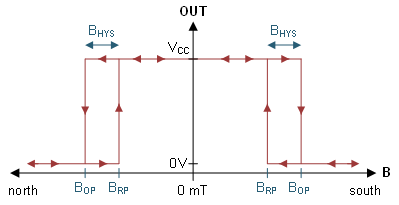-
Implementing Programmability and Diagnostics With the TMAG5328 Resistor and Voltage Programmable Hall-Effect Switch
Implementing Programmability and Diagnostics With the TMAG5328 Resistor and Voltage Programmable Hall-Effect Switch
Abstract
This application note discusses how the TMAG5328 resistor and voltage adjustable, low-power Hall-effect switch can increase system design flexibility and reduce design time. In addition, the document also discusses how using voltage to adjust the TMAG5328’s BOP enables multiple applications. One of these applications is a software programmable Hall-effect switch with microcontroller-less standalone mode, which is done by using a DAC or digital potentiometer with nonvolatile memory. Additionally, the document discusses how sweeping the voltage that sets the BOP can be used to back-calculate the sensed magnetic flux density seen by the TMAG5328. This document also discusses how adding a square wave voltage waveform can help the TMAG5328 implement diagnostics for detecting faults such as TMAG5328 device pin shorts, TMAG5328 device pin disconnections, and when a system’s magnet is either too close or too far from the sensor. The magnet out-of-range functionality implemented for diagnostics can also be reused as a magnetic window comparator instead.
Trademarks
All trademarks are the property of their respective owners.
1 Introduction
Many systems require a mechanism to detect the mechanical position between a moving component in the system and a fixed component. Systems that only require a simple binary detection of position are often implemented by placing a magnet on the movable component and a Hall-effect switch on the fixed component (the base). An example of an open/close detection system is the mechanism in refrigerators that detect when the refrigerator’s door (the moving component) is open or closed, which determines when to turn ON or OFF the refrigerator light. In Figure 1-1, a magnet is placed on the moving refrigerator door and the Hall-effect switch is placed on a fixed PCB underneath the refrigerator base. In this example, it is assumed that the center of the magnet is directly above the sensing element of the Hall sensor when the refrigerator door is closed.
Figure 1-1 Example Open/Close Detection System With Hall-Effect Sensors and Magnet.
Figure 1-2 shows an example output graph of the TMAG5328 omnipolar Hall-effect switch. The device in Figure 1-2 is an omnipolar device, therefore the output responds to both positive and negative magnetic flux densities, which means the device responds the same regardless if the north or south pole of a magnet approaches the device. As the magnet approaches the Hall-effect switch, the magnitude of the sensed magnetic flux density increases. When the applied magnetic flux density exceeds the BOP threshold, the device in Figure 1-2 outputs a low voltage. The output of the device in Figure 1-2 stays low until the magnetic flux density decreases to less than BRP, and then the output drives a high voltage.
 Figure 1-2 Output Graph of the
TMAG5328 Omnipolar Switch.
Figure 1-2 Output Graph of the
TMAG5328 Omnipolar Switch.